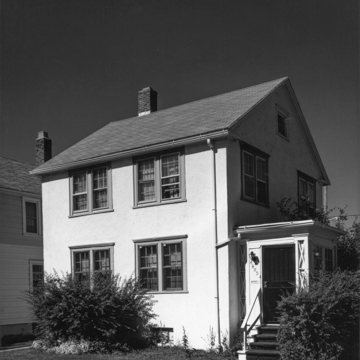The Garden Homes district was the nation’s first and only municipally sponsored, cooperatively owned housing project. As a public sector enterprise, it was a legacy of Milwaukee’s Socialist government. Socialist mayors presided in Milwaukee for most of the period between 1910 and 1960. Garden Homes’ roots lay in the housing shortage of the early twentieth century. In the 1910s, the city’s robust economy was generating more jobs and attracting more workers than the city’s housing supply could accommodate. When Emil Seidel became Milwaukee’s first Socialist mayor in 1910, he pledged to ease the housing crisis. Although Seidel was defeated in 1912, the idea for city-built housing reemerged in the late 1910s under Daniel Hoan, Milwaukee’s second Socialist mayor.
During World War I, Milwaukee applied unsuccessfully for emergency federal aid to build housing for workers. So, in 1919, it proposed the formation of a cooperatively owned housing corporation. The corporation would build houses, using capital supplied by local government and local business leaders. Initially, occupants of the houses would not own their homes but would gradually purchase stock in the corporation equal to their house’s value, making a 10 percent down payment followed by monthly payments over the next twenty years. As tenants purchased housing stock, they bought out the business leaders and government agencies that put up the original capital.
The idea of a municipally sponsored housing cooperative was new to America, but it had ample precedent in England, where many were established between 1900 and 1920. Garden Homes owed a debt (as well as credit for its name) to the garden concept of town planning, devised by English social and urban reformers in the late nineteenth century. Milwaukee planners selected a twenty-nine-acre area north of the existing city, surrounded by agricultural land. Their fan-like curvilinear streets also rerouted N. 26th Street around a two-acre public park. Schuchardt designed nine different cottages to place on generous lots. The houses came in varying sizes, layouts, and lot orientations and were two stories tall, set atop raised basements, clad in stucco and roofed with green or red asphalt shingles. Many were Colonial Revival in style. The Milwaukee planners named streets after some of the famous English developments: Letchworth, Hampstead, Bourneville, and Port Sunlight.
Milwaukee city and county government held the controlling majority interest with initial capital provided by thirty-eight local business leaders. Although this cooperative housing project was not inherently socialist, it was government sponsored and controlled. Ground was broken in the fall of 1921, and the houses were built of energy-, labor-, and cost-saving materials. Houses were built in consecutive order using assembly-line techniques, with work crews moving from one house to the next, performing the same job on each one. Garden Homes was not the nation’s first example of mass-produced housing, but it presaged the massive tract-house developments prevalent a quarter-century later. Thanks to rapid construction, the first residents moved into their houses a year after groundbreaking. By 1923, when construction stopped, crews had built 93 structures, which housed 105 living units.
Due to its novel nature, the project met with mixed success. From the time Garden Homes was first proposed, it generated intense opposition from politicians and business leaders who claimed that cooperative housing was un-American and smacked of Bolshevism. But the greatest opposition to the cooperative housing plan came from the residents. A number complained of government paternalism, objecting to charges for community improvements beyond the cost of their houses, and worried that cooperative ownership would prevent selling their houses for a fair (or high) price. The Garden Homes cooperative disbanded in 1925, and the development converted to individual ownership.
Many residents sold their Garden Homes, and by the late 1930s only about 40 percent of the original tenants lived in the subdivision. After World War II, the original Garden Homes plan withered. The agricultural greenbelt around the village filled with urban development, and most of the English-inspired street names have been changed to match those of the surrounding city. Many of the homes were modified after their stucco cladding failed. Despite the changes, the Garden Homes district’s curving streets impart a separate character from the surrounding grid-pattern neighborhoods. Though covered with shingles or siding, the houses are still recognizable as part of a homogeneous development, and West Port Sunlight Way remains to recall this neighborhood’s idealistic beginnings.


